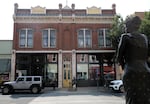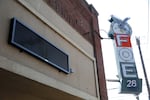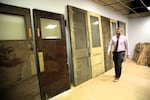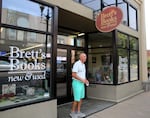
Stephanie Huffman stands outside the Odd Fellows Building in downtown Pendleton, Ore. The building is being renovated for residential lofts and a restaurant.
Kristian Foden-Vencil / OPB
Fiber artist and planning technician Stephanie Huffman is proud of historic downtown Pendleton and happy to give a tour.
“In the late 1800s the railroad came to Pendleton, and that really increased people’s wealth,” Huffman said recently as she pointed to a row of historic old brick buildings along Main Street. Many of the old edifices feature ornate archways, cornices and dentil moulding. But back in the 1960s and 1970s, some were renovated.
“The idea was to modernize,” Huffman said. “That meant putting stucco all over the buildings. And everybody thought it looked great at the time. But over the years, opinions change. People started thinking, ‘This doesn’t look historical at all. Let’s take the stucco off.’”

The rise of the railroad helped create Pendleton, and that heritage can still be found in many downtown buildings. Now the city is working on how to restore some of that frontier history while giving businesses the modern signs they say they need.
Kristian Foden-Vencil / OPB
Over the last few years, Pendleton’s Urban Renewal Project has spent about $7 million helping owners uncover some of downtown’s old splendor. And more people are moving downtown. Between 2021 and 2022, the city added 144 new residents, bringing the total population to just over 17,000.
But more people can bring more problems. For example, the Fraternal Order of Eagles recently put up an electronic message board on its historic building. The board is a collection of colored pixels, like a computer screen, so the messages can change quickly or light up to attract attention.
“Those kinds of signs actually cause a lot of conflict,” said Julie Chase, Pendleton’s city planner.
“When you’re eating dinner, and you’ve got this sign flashing across your face, and that’s what the kids see,” she said. “When you’re trying to go to bed and you can’t because the sign is just flashing repeatedly. That causes a conflict.”
After a number of complaints, the Eagles turned their message board off.

The new electronic message board next to the old historic Eagles sign in downtown Pendleton.
Kristian Foden-Vencil / OPB
Still, Chase was wondering what to do about such new electronic message boards when the Children’s Museum of Eastern Oregon said it wanted a big new mural downtown. She checked city code and found that there are no criteria by which to gauge murals.
“I said: ‘Well this is a big no no,’” she said. “’You can’t write a report if you have no means to judge it.’”
The upshot was that this March, Pendleton city leaders passed a moratorium on all new murals and electronic message boards. The city’s Historic Preservation Commission drew up a proposed new ordinance that was unveiled at a public meeting this June.
“What was brought forward was not well received by the community,” said Chase.
Lots of different kinds of signs were prohibited in the initial ordinance, including electronic reader boards and billboards.
Local attorney Brandon Foy was at that first meeting. He’s renovating a downtown building and said new rules need to encourage, not discourage, development.
“It did seem to be a little bit too draconian with ruling certain things out,” Foy said. “Especially when there were types of signs that were ruled out that were already recognized by the city as having historical significance.”

Brandon Foy walks past the old doors he found in the building he's renovating in downtown Pendleton.
Kristian Foden-Vencil / OPB
Brett Mulvihill owns a bookstore downtown. He just got elected to the Pendleton City Council and says business owners are concerned.
“Signs are very expensive, and so there’s some question about if they’d spent money on a sign that was not approved,” Mulvihill said. “How would that affect them?”
His own sign is just a painted piece of wood. “Hopefully it’s grandfathered in,” he said.
Chase, the city planner, said there was a lot of misinformation swirling around that first meeting.
“One member of the community said, ‘I’m not going to be able to do my sandwich board.’ And we had to correct them and say, ‘No, sandwich boards are allowed.’” she said. “Another member was worried about wall signs. Those are allowed. Another member was worried about painted signs, allowed. Neon signs, also allowed.”

Brett Mulvihill owns Brett's Books in downtown Pendleton. “Signs are very expensive and so there’s some question about if they’d spent money on a sign that was not approved,” Mulvihill said. “How would that affect them?” Aug. 7, 2024
Kristian Foden-Vencil / OPB
Chase said even electronic reader boards are allowed for establishments such as cinemas, theaters and churches, because their movies, shows and sermons are constantly changing.
The new ordinance proved so divisive it was sent back to the Historic Preservation Commission, which is now rewriting the proposed policy.
Deciding what does and doesn’t fit in an historic downtown is not easy. Anyone who’s seen the sleek glass roof that floats over the historic Smithsonian American Art Museum in Washington D.C., or the renovated Meier & Frank building in Portland, can understand that new things can add excitement to an historic area.
Related: Faded ‘ghost signs’ given new life in Astoria
Laurie Matthews, who teaches historic preservation at the University of Oregon, said good historic ordinances take time and expertise to craft.
“It comes down to materials and scale and color and texture. All the things that designers get excited about,” she said.
She cited Sisters, Oregon, as a place that has succeeded at using its history — in this case, a business district that carries a frontier theme — to stop people who might otherwise drive straight through.
“We are looking for authentic and unique places, and historic districts have that kind of draw for us as humans,” Matthews said.
“We are keen to explore places that speak to a different time and place but also have something that is not our usual or every day,” she said.
A new draft of the sign ordinance is expected in November.
